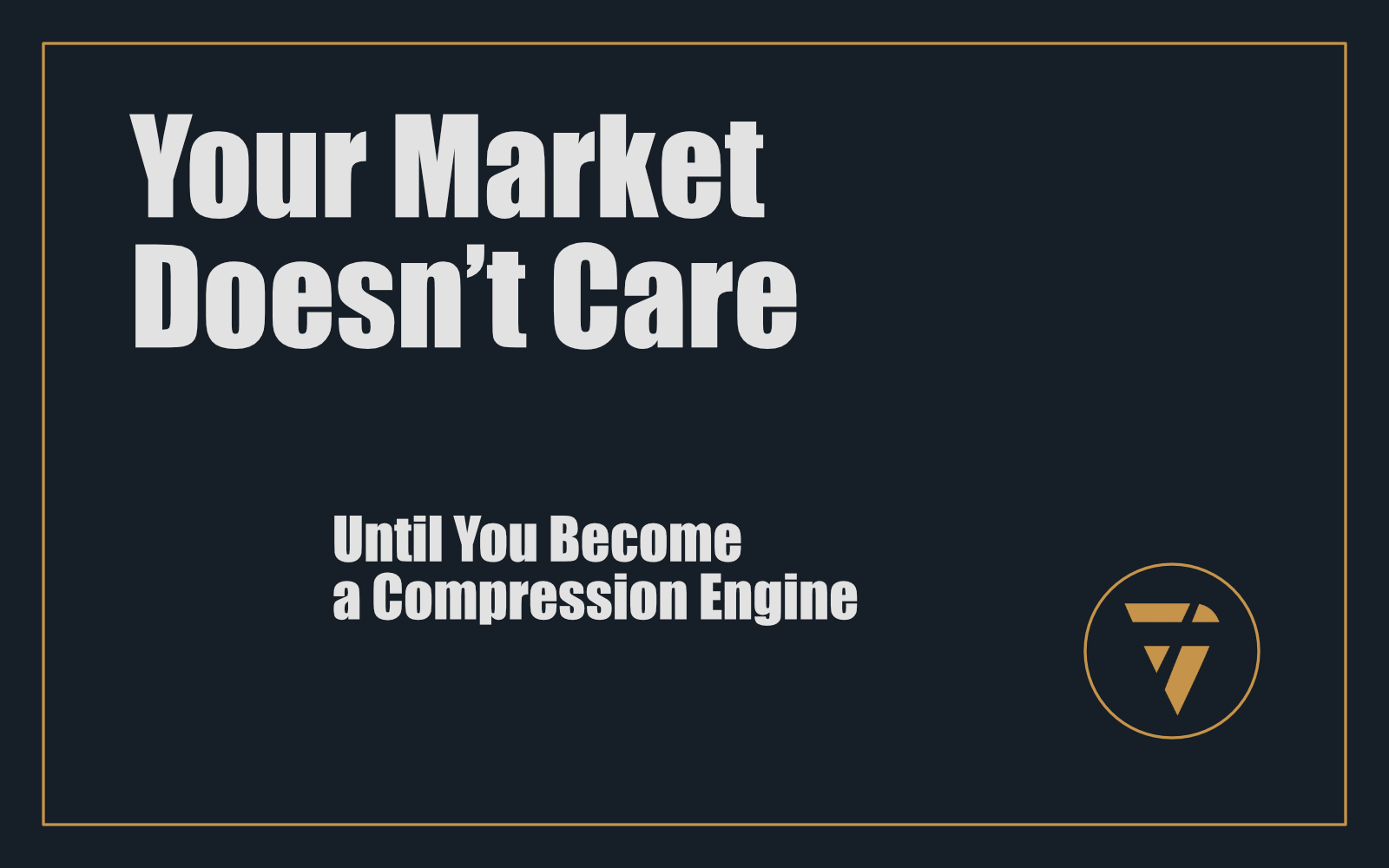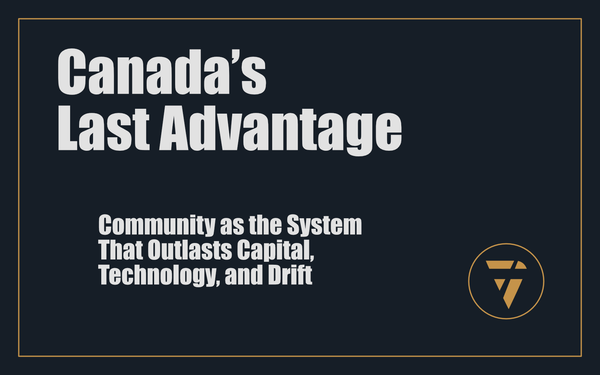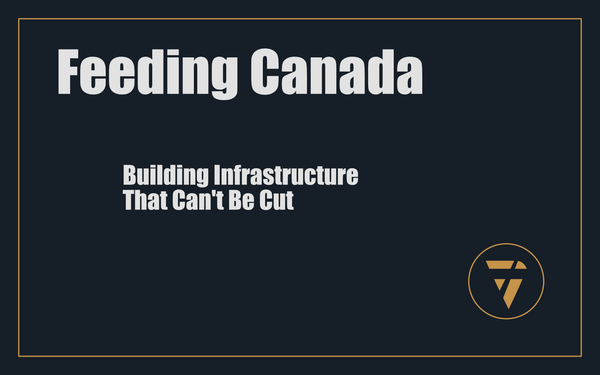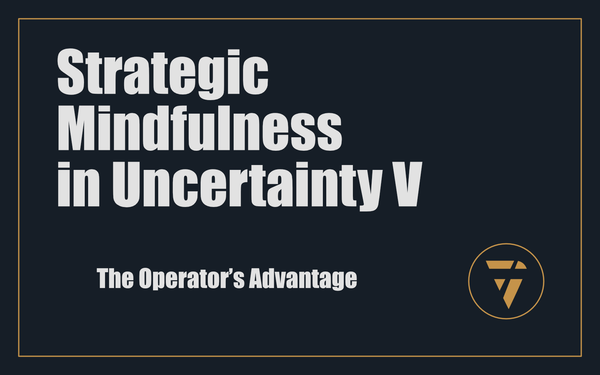Your Market Doesn’t Care

Until You Become a Compression Engine
Markets are not sentimental. They do not care how smart you are, how hard you work, or how much you want it. They don't reward intention. They reward deletion.
Nobody pays for help.
They pay for removal.
Removal of time.
Removal of friction.
Removal of uncertainty.
The value of your offer is directly proportional to how quickly, cleanly, and permanently you can delete a known problem. Not explain it. Not dance around it. Not frame it. Delete it.
Let’s be uncomfortably clear:
If your customer still has to think, plan, coordinate, wait, wonder, or revise—then you haven’t delivered value. You’ve transferred effort. And markets don’t reward that.
They only reward compression.
Compression of motion.
Compression of attention.
Compression of cost, risk, and drag.
The more you compress—the more you command.
This is the force of compression:
- Time Compression = Profit Compression
If you reduce a 90-day transformation to 9 days—you win.
Why?
Because time is not neutral. It's a tax. And every additional day your customer carries their problem is a penalty they subconsciously charge you for.
Slow fulfilment is theft.
It steals momentum. It steals trust. And it forces the buyer to manage their own doubt while your solution “boots up.”
Speed is not a luxury add-on.
It’s the core product.
If you can’t compress time, don’t scale.
Structural Fix:
Audit every customer journey for:
- Delays in onboarding
- Manual transitions
- Multi-step handoffs
- Client-side homework
Then compress until the outcome is so fast it feels like cheating.
Your customer doesn’t want to work with you.
They want to be changed by you.
- Cognitive Compression = Category Leadership
Confused markets don’t buy.
Every extra second a buyer spends decoding your offer, comparing your product, or clarifying your process is a second your competitors gain ground.
Clarity is not just communication.
It’s domination.
Because when your offer is unmistakable—price becomes irrelevant. When your value is unmistakable—competition evaporates.
If your sales page requires a scroll, you’re already bleeding trust.
Structural Fix:
Every offer must answer these three questions in 7 seconds or less:
- What do you delete?
- How fast do you delete it?
- Why are you the only one who can?
This is not positioning. This is permission. You don’t earn the right to sell until you’ve deleted doubt.
Compress until belief becomes reflex.
- Effort Compression = Retention Engine
Customers don’t churn because of your product. They churn because of your process.
If your system demands input, attention, or navigation—they will leave.
Why?
Because most buyers don’t want tools. They want transfers.
They want you to take the burden, the steps, the thinking—and remove it from their plate.
That’s what they paid for.
Structural Fix:
Every feature, dashboard, or service layer must be audited for:
- Steps required to activate
- Learning curves per user persona
- Hidden decisions or micro-confusions
Then install guided execution or done-for-you paths that make fulfilment feel like gravity.
The less they have to do—the more they will stay.
- Risk Compression = Deal Acceleration
The reason your deals stall is not because of budget.
It’s because of exposure.
If your customer has to bet political capital, internal resources, or brand equity on you—they’ll hesitate.
And they should.
Because you’ve asked them to make a leap without a bridge.
Your job is to build the bridge. In advance. At speed. With steel.
Structural Fix:
Compress perceived risk by embedding:
- Fast fail conditions (exit in 30 days)
- Outcome insurance (re-do or refund)
- Stakeholder previews (executive summaries, pilot models)
You are not just selling a product.
You are selling the removal of fear.
- Outcome Compression = Brand Moat
This is where compression becomes identity.
When your market knows that buying from you guarantees a faster, cleaner, more irreversible deletion of their pain—you stop being an option.
You become the default.
And the default doesn’t compete. It extracts.
Because default status creates compression at scale:
- Less time spent explaining
- Fewer competitors considered
- Shorter sales cycles
- Higher lifetime value
Your brand is not your look.
It’s the velocity with which people expect you to solve something.
Structural Fix:
Map your core value to a repeatable deletion pattern:
- Problem: What do they fear?
- Trigger: When do they feel it?
- Outcome: How do you remove it?
Then wrap your entire messaging, sales, and delivery systems around that deletion.
If the market doesn’t feel the compression—your message is decoration.
Here’s the compression checklist:
- Does this delete a real pain?
- Does it compress the steps to get there?
- Does it reduce time, risk, or effort?
- Is the value felt immediately?
- Can the customer repeat the benefit in one line?
If not—start again.
The market does not reward generalists.
It rewards compression engines.
You want to scale? Compress harder.
You want to lead? Delete more.
You want to dominate? Make every customer feel like you collapsed a year of frustration into a 10-minute victory.
Because the truth is brutal:
The market doesn’t care.
Until you become the thing that deletes its problem—faster, cleaner, and more clearly than anyone else.
Then it won’t just care.
It’ll depend on you.
This is what I’m working on. Tell me what you think, I enjoy the conversation! Subscribe and follow the work in real time.
Thanks!
B

Nobody pays for help.
They pay for removal.
Of time.
Of friction.
Of uncertainty.
The faster you vanish pain, the faster you dominate.
You’re not a brand. You’re a deletion engine.
Compress or be forgotten.
PS -

You are not paid for what you do.
You are paid for what you eliminate.
This is the law of compression.
And the market is ruthless in its enforcement.
Your clients don’t wake up craving your offer.
They don’t want your method, your philosophy, your frameworks.
They want one thing:
To never think about the problem again.
Nobody pays for help. They pay for removal.
Every great business is a deletion engine.
And every founder stuck in noise is still trying to impress instead of erase.
Here’s how to become irreplaceable:
1. Compress Time
The old model: “Here’s how we’ll work together.”
The compression model: “Here’s how this disappears by Thursday.”
Stop walking people through your process.
Start owning the timeline of their freedom.
Action:
Rewrite your offer in units of time returned, not effort delivered.
Install time-stamped outcomes:
- “You’ll be out of inbox overload in 3 days.”
- “You’ll be closing deals without proposals in 7 days.”
- “Your churn will drop by 30% in 21 days.”
If time isn’t the metric—your offer is noise.
2. Compress Complexity
Confusion is the enemy of conversion.
Your buyer doesn’t want to understand your genius.
They want permission to stop thinking.
Action:
Delete the steps. Deliver the result.
Turn your 7-step roadmap into one sentence:
“Onboarding, integration, and live results in one call.”
Your buyer doesn’t want to be educated.
They want to be exited—from their pain.
3. Compress Risk
Buyers hesitate when they see risk.
The risk of wasting time.
The risk of looking stupid.
The risk of bringing in another “expert” that overpromises and underdelivers.
Compression destroys hesitation.
Action:
Replace every “we might” with “we guarantee.”
Risk is removed by structural proof:
- Money-back mechanisms
- Timeline clauses
- Specific success metrics
- Performance-based pricing
If you wouldn’t bet on your own outcome—why should they?
4. Compress Decision Friction
Your buyer has 12 tabs open.
Three pitches in their inbox.
A backlog of half-baked offers swirling in their head.
You don’t need to win the market.
You need to delete every other option.
Action:
Create an offer so compressive that it shuts down comparison.
This is what compression looks like:
- “We handle the copy, the build, the launch, and the follow-up.”
- “You speak once. We turn it into 30 days of content, ads, and authority.”
- “We eliminate your marketing, sales, and tech headaches in one pipeline install.”
If they can still think of another solution—you haven’t compressed hard enough.
5. Compress Identity Complexity
Founders get stuck trying to “find their brand voice.”
They wait for a perfect narrative before they sell.
Meanwhile, the market isn’t listening.
It’s looking.
Looking for the one who removes pain the fastest.
Action:
Stop performing identity.
Start performing deletion.
You don’t need a tagline.
You need a reputation: They make it go away.
Your brand is the compression engine.
Not the aesthetic.
The Compression Checklist:
- Is your offer described in units of time, not effort?
- Can your buyer explain it to a colleague in one sentence?
- Is your outcome riskless—or just vague confidence?
- Does it delete every alternative—or open the door to options?
- Is your identity anchored in speed and precision—or decoration?
Your market doesn’t care until you compress.
Until you name the exact problem, time-stamp its deletion, and guarantee the collapse of friction—
you are invisible.
Your job is not to help. Your job is to vanish the problem.
Now cut every word, step, delay, and explanation that doesn’t delete pain.
And watch what happens next.
Let’s move.






